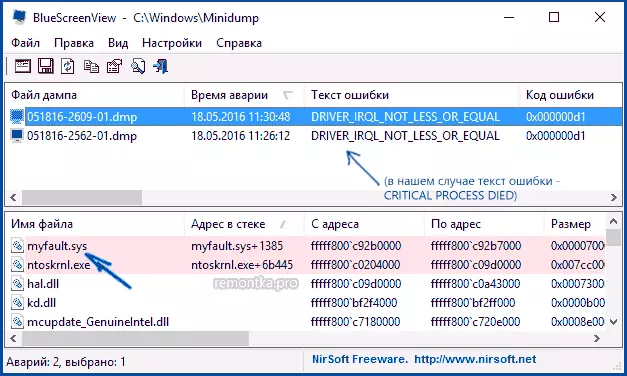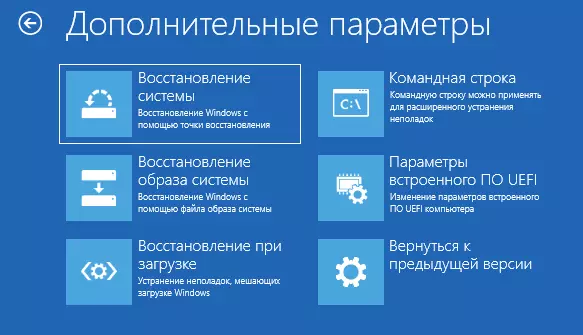
In this manual, it is detailed that it may be the reason for the emergence of a problem and how to correct the error Critical Process Died in Windows 10 (also an error can be displayed as Critical_Process_died on the blue screen in versions of Windows 10 to 1703).
Causes of error
In most cases, the Critical Process Died error causes the device drivers - in cases where Windows 10 uses drivers from the update center, and the original manufacturer drivers are required, as well as other incorrect drivers.Other options happen - for example, with a blue screen Critical_Process_died, you can encounter after operation of cleaning programs from unnecessary files and the Windows registry, if there are malicious programs on your computer and in case of damage to the system system files.
How to Repair Critical_Process_died Error
In case you receive an error message immediately when you turn on the computer or input in Windows 10, you first go to the safe mode. You can do this in various ways, including when the system is not loaded, in detail about it in the instructions Safe Windows 10 mode. Also using a clean download of Windows 10 can temporarily help get rid of the Critical Process Died error and perform actions for full elimination.

Methods of correction, if you manage to log in in Windows 10 in the usual or secure mode
First consider ways that can help in a situation where Windows is possible. Start recommending from viewing stored memory dumps that are created by the system automatically during critical failures (unfortunately, not always, sometimes automatically creating memory dumps is disabled. See how to enable the creation of memory dumps during failures).
For the analysis it is convenient to use the free BlueScreenView program available to download on the developer page https://www.nirsoft.net/utils/blue_screen_view.html (download links are at the bottom of the page).
In a very simplified version for novice users, the analysis may look like this:
- Run the BlueScreenView program
- View .SYS files (usually needed exactly, although the list part can be present with Hal.dll and ntoskrnl.exe), which will be displayed at the top of the table in the bottom panel of the program with an empty second "Address in Stack" column.

- Using the search on the Internet, find out what it is for the .sys file and which driver it represents.
Note: You can also try to use the free WHOCRASHED program, which can report the accurate name of the driver that caused the error.
If 1-3 steps succeed, then then it will only solve the problem with the identified driver, usually this is one of the following options:
- Upload the driver file from the official site of the laptop or motherboard (for PC) and install it.
- Roll back the driver if it is recently updated (in the device manager, right click on the device - "Properties" - the "Driver" tab - button "Run").
- Disable the device in device manager if it is not critical for operation.
Additional correction methods that can help in this scenario:
- Manual installation of all official drivers (Important: Some users mistakenly believe that if the device manager reports that the driver does not need update and "The device works fine", then everything is in order. This is often wrong. Official drivers take from the manufacturer of your equipment : For example, REALTEK audio drivers download not with Realtek, but the manufacturer's website manufacturer for your model or from the laptop manufacturer's site, if you have a laptop).
- Using recovery points, if available and if recently mistakes did not let yourself know. See Windows 10 Recovery Points.
- Checking a computer for malicious programs (even if you have a good antivirus), for example, using ADWCleaner or other means of removing malicious programs.
- Check the integrity of Windows 10 system files.
How to fix the Critical Process Died error if Windows 10 does not start
A more complex option - when the blue screen with an error appears before logging in to Windows 10 without the ability to launch special download options and a safe mode (if such an option is, you can use previous solutions in safe mode).
Note: If after several unsuccessful downloads you have the recovery environment menu, then create a bootable flash drive or disk, as described below, do not need. You can use the recovery tool from this menu, including the system reset in the "Advanced Settings" section.
Here you will need to create a bootable flash drive from Windows 10 (or recovery disk) on another computer (the bit of the system on the drive must match the battery of the installed system on a problem computer) and boot from it, for example, using boot menu. Next, the procedure will be as follows (an example for loading from the installation flash drive):
- On the first screen of the installation program, click "Next", and on the second, at the bottom of the left - "system restoration".

- In the "Select Action" menu, go to "Troubleshooting" (optional parameters ").

- If you have, try using the system recovery points (System Restore Point).
- If they are lacking, try opening the command line and check the integrity of system files using SFC / SCANNOW (how to make it from the recovery environment, in detail in the article How to check the integrity of Windows 10 system files).
Additional solution solutions
If no ways do not help correct the error among the remaining options:
- Running Windows 10 (you can save data). If the error appears after logging into the system, the reset can be performed by pressing the power button shown on the lock screen, then holding the SHIFT - reboot. The recovery environment menu opens, select "Troubleshooting" - "Return the computer to the original state." Additional options - how to reset Windows 10 or automatic reinstalling OS.
- If the problem arose after the use of the program for cleaning the registry or the like, try to restore the Windows 10 registry.
In the absence of a solution, I can only recommend to remember that it preceded the appearance of an error, to identify regularities and try somehow cancel the actions that led to the problem, and if it is not possible - to install the system again. Here you can help instructions for installing Windows 10 from a flash drive.
